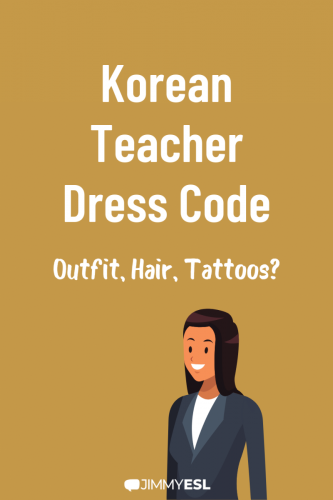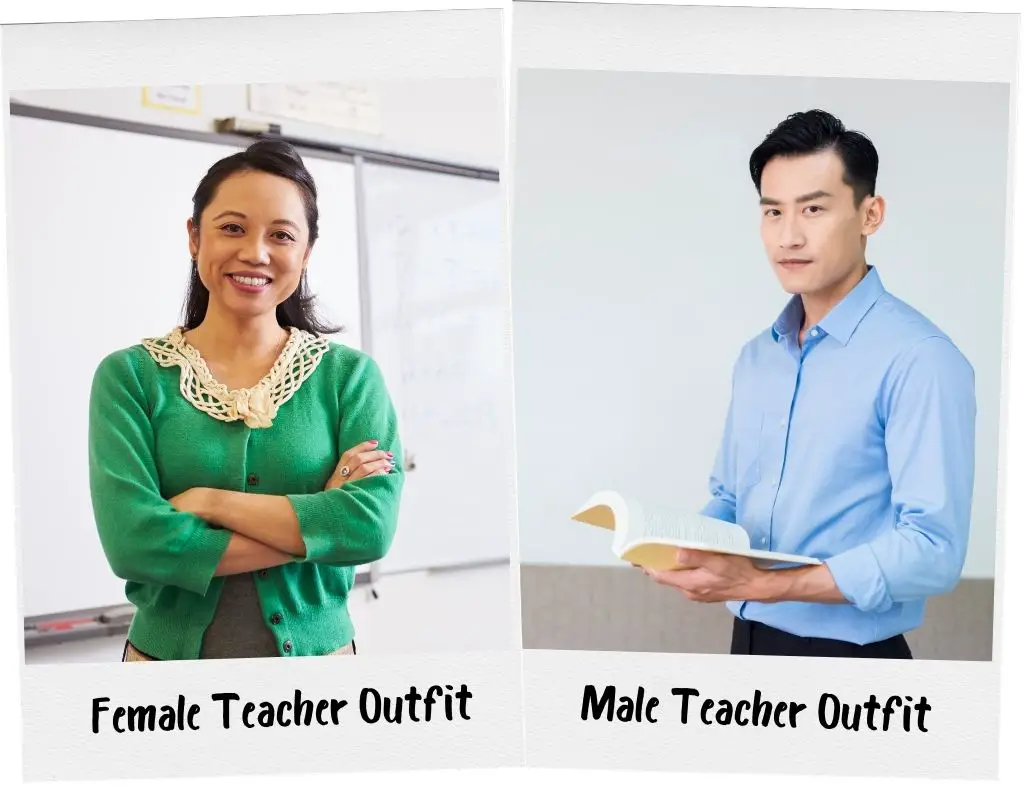When you are a teacher, you have to earn the respect of your students. Appropriate dressing therefore is crucial, especially when you teach ESL or another subject in a country with a very different culture, like Korea.
You might already know, that the dress code for teachers in Korea is more formal than in the western countries. But, in concrete terms, what does an appropriate outfit look like? What about hair, make-up and tattoos?
In this post, I’ll explain the Korean teacher dress code and touch upon the various Dos and Don’ts.
Join our mailing list to receive a free ESL teaching resource every week.

Dress Code for Teachers in South Korea
Teachers are highly regarded in South Korea and admired as authority figures. An ESL teacher (in Korean, 선생님 or Seon-sa-eng), should dress respectably and maturely.
Every school will establish its dress code for teachers, based not solely on culture, but also on other aspects. You’ll need to adapt to your specific school’s dress requirements.
There are different school types where ESL teachers work. These include:
- Public Schools
- Private English Schools (Hagwons)
- Universities
Public schools generally require a semi-professional look while hagwons and universities offer more flexibility.
Outfits for Female Teachers
For women, knee-length skirts or dresses, collared blouses, or sweaters with a pair of slacks are suitable. When teaching, it is not proper to reveal a lot of skin, so do avoid tank tops, sleeveless or low-cut tops and mini-skirts.
Women can wear shorts as long as the material is trouser style and not denim.
Outfits for Male Teachers
Men should wear collared shirts, dress shirts, or sweaters with a neat pair of slacks. They are discouraged from wearing shorts due to adverse feelings about visible body hair.

Prints on Clothes
Be mindful of images and messages printed on your clothes, especially when it comes to politics, religion, profanity, and sex. While they may be acceptable in your country, it’s wise to be respectful of South Korean culture and norms. Besides showing respect, you also want your students, parents, and school administrators to respect you, too.
Shoes
When entering someone’s home in South Korea, you’ll be expected to remove your shoes. This practice applies to schools as well.
You’ll put your outdoor shoes in cabinets when you enter the school building and wear slippers (in Korean, 실내화, or “sil-nae-hwa”). You can bring a pair of basic slippers with you from home.
When you meet with the school administrators, they will advise you if the ones you have are acceptable and, if not, where you can purchase appropriate ones.
Special Occassions
When thinking about what to wear, also think about your comfort. As a teacher, you will likely be animated. You want to wear clothing that allows you to move around comfortably.
There are times when teachers will be required to dress more formally, such as business luncheons or ceremonial functions. It’s a smart idea to have some formal attire handy for such occasions.
Clothes for the Different Seasons
There are four distinct seasons in South Korea, so you’ll need to bring suitable clothing to accommodate the weather changes. Additionally, you will need to bring work clothes that are acceptable to your school. Refer to your School Dress Code page for details.
In winter, the climate of South Korea is cold but sunny. In summer, it’s hot and humid with abundant rain. The spring and autumn seasons are short but pleasant.
South Korea can be affected by typhoons from July to early October and bring large amounts of rainfall and strong winds, most commonly on the south coast.
For winter, bring warm clothes, such as a down jacket, gloves, a scarf, and a hat.
Summer clothes should be light and made of natural fibers. A light raincoat or umbrella is recommended, as well as a light sweatshirt for air-conditioned places.
Hair Dressing
Your hair should be well-groomed and at an appropriate length. You can dye your hair, but be careful not to be too outrageous with your color choices.
Excessive facial hair is usually considered unacceptable. It’s best to be clean-shaven, but if you do prefer facial hair, make sure it is well-groomed and trimmed.
Jewelry and Accessories
South Korea is conservative when it comes to jewelry on men. It’s almost certainly going to be the case that schools prefer men not to wear any earrings or piercings.
Excessive jewelry and piercings are not appropriate for female teachers. To be safe, stick to modest jewelry.
Head coverings, such as hats, should not be worn in the classroom. If you have religious needs to have a head covering, it is best to clarify this with the school where you will be teaching beforehand.
Can You Teach in Korea with tattoos?
South Korea, like nearby neighbors Japan and China, still frown upon tattoos. However, they are increasingly becoming de-stigmatized, especially in younger generations. Tattoos tend to be less of a concern in urban centers, such as Seoul, where people are more accustomed to seeing them.
As you move out of urban areas, people tend to be more conservative, and tattoos still perceived negatively. Facial and neck tattoos will not be acceptable, and you may need to cover any tattoos on your arms.
You may be asked if you have tattoos, especially visible ones, on your school application or during your interview, so make sure you are honest about it to avoid issues that may arise in the future.
So, if you want to teach ESL in Korea, tattoos should not be an issue, as long as you can cover them, i.e., through long sleeves.
Buying XXL clothing in Korea
There is a saying in South Korea that “one size fits all, and that size is small.”
The larger cities carry most sizes of clothing, though, in non-urban areas, they are generally small. It may be hard to find extra-large sized clothing or footwear, so it’s best to carry some with you if you have difficulty finding these once you are there.
Dress a Little Better than You’re Expected
You will have many comfortable clothing options when teaching in South Korea, but always keep in mind that looks and appearance are paramount in how you are perceived professionally by your school, your students, and their parents. It’s still best to keep yourself looking clean, well-groomed, and smart, even when you’re dressed casually.
Dressing more conservatively may seem like an infringement on your style from back home, but it’s a small price to pay for a well-paid job and the chance to live overseas.